ABSTRACT
This paper introduces the design, implementation, and performance analysis of the scalable and mobility-aware hybrid protocol named boarder node medium access control (BN-MAC) for wireless sensor networks (WSNs), which leverages the characteristics of scheduled and contention-based MAC protocols. Like contention-based MAC protocols, BN-MAC achieves high channel utilization, network adaptability under heavy traffic and mobility, and low latency and overhead.
Like schedule-based MAC protocols, BN-MAC reduces idle listening time, emissions, and collision handling at low cost at one-hop neighbor nodes and achieves high channel utilization under heavy network loads. BN-MAC is particularly designed for region-wise WSNs. Each region is controlled by a boarder node (BN), which is of paramount importance. The BN coordinates with the remaining nodes within and beyond the region. Unlike other hybrid MAC protocols, BN-MAC incorporates three promising models that further reduce the energy consumption, idle listening time, overhearing, and congestion to improve the throughput and reduce the latency.
One of the models used with BN-MAC is automatic active and sleep (AAS), which reduces the ideal listening time. When nodes finish their monitoring process, AAS lets them automatically go into the sleep state to avoid the idle listening state. Another model used in BN-MAC is the intelligent decision-making (IDM) model, which helps the nodes sense the nature of the environment. Based on the nature of the environment, the nodes decide whether to use the active or passive mode.
This decision power of the nodes further reduces energy consumption because the nodes turn off the radio of the transceiver in the passive mode. The third model is the least-distance smart neighboring search (LDSNS), which determines the shortest efficient path to the one-hop neighbor and also provides cross-layering support to handle the mobility of the nodes. The BN-MAC also incorporates a semi-synchronous feature with a low duty cycle, which is advantageous for reducing the latency and energy consumption for several WSN application areas to improve the throughput.
BN-MAC uses a unique window slot size to enhance the contention resolution issue for improved throughput. BN-MAC also prefers to communicate within a one-hop destination using Any cast, which maintains load balancing to maintain network reliability. BN-MAC is introduced with the goal of supporting four major application areas: monitoring and behavioral areas, controlling natural disasters, human-centric applications, and tracking mobility and static home automation devices from remote places. These application areas require a congestion-free mobility-supported MAC protocol to guarantee reliable data delivery.
BN-MAC was evaluated using network simulator-2 (ns2) and compared with other hybrid MAC protocols, such as Zebra medium access control (Z-MAC), advertisement-based MAC (A-MAC), Speck-MAC, adaptive duty cycle SMAC (ADC-SMAC), and low-power real-time medium access control (LPR-MAC). The simulation results indicate that BN-MAC is a robust and energy-efficient protocol that outperforms other hybrid MAC protocols in the context of quality of service (QoS) parameters, such as energy consumption, latency, throughput, channel access time, successful delivery rate, coverage efficiency, and average duty cycle.
RESEARCH GOALS, CHALLENGES, AND CONTRIBUTIONS
One of the key goals of introducing BN-MAC is to support the multiple application domains of WSNs. We focus on several characteristics and factors that affect the performance of existing hybrid MAC protocols and BN-MAC. Factors that affect energy consumption and scalability include idle listening, overhearing, congestion, and mobility. The key challenge is determining how to integrate all of the proposed models to work as a single unit. Mobility is also difficult to address due to limitations and constraints at the MAC layer for maintaining scalability.
RELATED WORK
Although the deployment of WSNs has highly fascinated academia and industry, WSN platform has been experiencing several kinds of challenges due to many limitations and constraints. The WSN performance depends on an efficiency of the MAC protocol. The necessity of multi-featured MAC protocol is of paramount importance to handle mobility based scenarios for several real time WSN applications. The salient features of most related work are discussed. We emphasize some of the known hybrid MAC protocols. The hybrid protocol named Z-MAC is introduced that integrates the features of both TDMA and CSMA techniques. In Z-MAC, CSMA is used as a baseline and TDMA resolves conflicts by scheduling the channel access.
SYSTEM MODEL FOR BN-MAC

Figure 1. Proposed simulated WSN
We have focused on a combined mobility and static scenario using the ns2 network simulator in the scenario depicted in Figure 1. Each static and moving object is connected with a command node. The command node is a heterogeneous node that obtains event information through homogenous nodes fixed in the field. Similarly, the command node forwards the collected information using the (homogenous) sensor nodes to the BN. In this scenario, the battlefield is dispersed into different regions. Each region covers several command nodes that gather information from the events.
BN-MAC PROTOCOL DESIGN
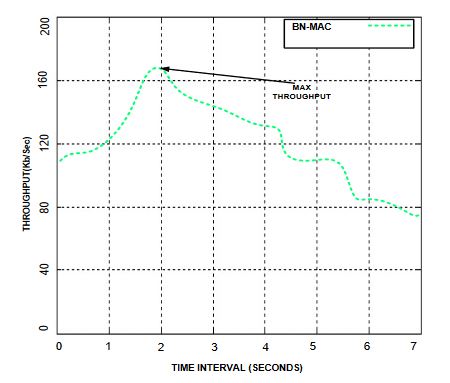
Figure 2. Throughput at different time intervals
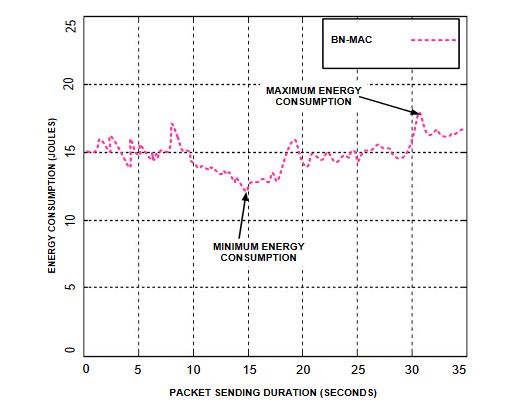
Figure 3. Packet sending duration versus energy consumption
The node is unable to complete the packet sending cycle when the time is less than 15s, and when the time is greater than 15s, the node comes into the idle situation because after finishing the packet sending task and thus waits on the channel until the level of set time is reached. We present the performance of the BN-MAC at different time intervals and packet sending durations in Figures 2 and 3. A comparison of BN-MAC and Z-MAC, the nodes of which use 30s for the neighbor discovery process, indicates that Z-MAC has higher energy consumption.
AUTOMATIC ACTIVE AND SLEEP (AAS) MODEL
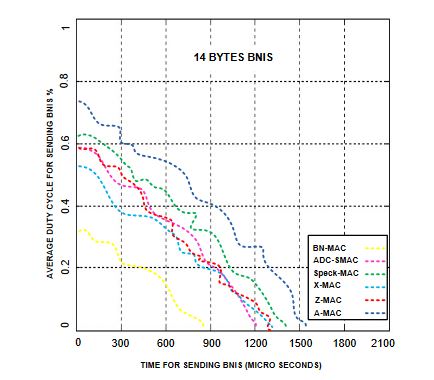
Figure 13. Time consumption for sending a BNIS message with BN-MAC and other MAC protocols
BN-MAC requires 832 μs to send a 14-byte BNIS message that produces a 0.3% duty cycle; other hybrid MAC protocols require an average of 1, 209–1, 532 μs to send each BNIS message that produces an average of 0.52–0.78 duty cycles, as shown in Figure 13. Thus, BN-MAC reduces the overhead by using fewer BNIS control messages and a synchronization message.
INTELLIGENT DECISION-MAKING (IDM) MODEL
We use the IDM model to increase the efficiency of BN-MAC. This model decides the nature of the environment, i.e. , whether the environment is indoor or outdoor. The IDM model forces the sensor nodes to work on either the passive or active mode of communication in response to the nature of the environment. The IDM model helps to reduce energy consumption in both modes but particularly in the passive mode. The sensor nodes working in the passive mode do not consume the energy of their battery but may instead harvest energy, such as solar energy from the environment.
SIMULATION SETUP AND ANALYSIS OF RESULTS
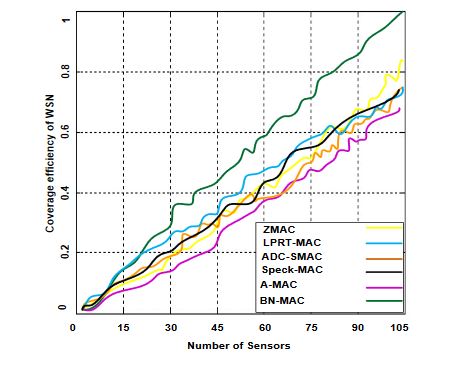
Figure 14. Coverage efficiency of the WSN using a different number of sensor nodes
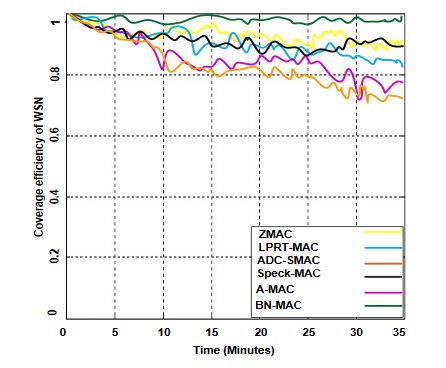
Figure 15. Coverage efficiency of the network at different intervals
The coverage is also crucial for maintaining the connectivity, which is defined as the capability of the sensor nodes to reach the base station. To measure the network coverage, we have created 15 sessions simultaneously to determine the actual behavior of the network using highly congested network scenarios. The simulations indicated that BN-MAC achieved a network coverage of 99.8%, whereas Z-MAC, A-MAC, Speck-MAC, ADC-SMAC, and LPRT-MAC achieve network coverage of 50 %–87%, as shown in Figures 14 and 15.
DISCUSSION OF RESULTS
Energy consumption has been known to be one of the greatest challenges of WSNs and will continue to be an immense challenge for the deployment of WSNs because the advancement in battery technology has been slower than the growth of processing power and data communication rates. This challenge has attracted researchers to introduce several new energy-efficient protocols to address this problem.
To address this challenge, several MAC protocols have been introduced at the MAC level. Hybrid MAC protocols are of paramount importance because they have lower energy consumption and better scalability than other categories of MAC protocols. In this section, we discuss and compare the strengths and weaknesses of BN-MAC versus other hybrid MAC protocols.
CONCLUSIONS
This paper introduces a new energy-efficient BN-MAC hybrid protocol with mobility support. The BN-MAC is proposed and simulated for the battlefield scenario over WSNs. The protocol leverages the features from both CSMA and TDMA. CSMA features embedded in BN-MAC consist of semi-synchronization, which uses a short preamble to access the channel and maintain the schedule at the one-hop neighbor nodes. TDMA features are imported into BN-MAC for collision-free data delivery.
We have introduced the IDM model, which automates the sensor nodes to work either in the passive or active mode with respect to the environment. The IDM model reduces the energy consumption when working in the passive mode. BN-MAC also has a reduced idle listening time based on the use of the AAS model. The AAS model forces the sensor nodes to go into the sleep state after collecting information on the events.
Latency is reduced using the LDSNS model and EAP routing protocol. LDSNS provides the efficient one-hop path search. EAP is suitable for maintaining route discovery and path maintenance at the one-hop destination for faster data delivery. BN-MAC also uses two types of messaging schemes to control congestion and reduce latency: Anycast is used to obtain information from the one-hop neighbors, and unicast is used to forward the data. To evaluate the features of the proposed BN-MAC in the battlefield scenario, we used ns2.35-RC7 to demonstrate the performance from different perspectives.
We have also simulated other hybrid protocols, such as Z-MAC, A-MAC, ADC-SMAC, LPRT-MAC, and Speck-MAC. The simulation results demonstrate that BN-MAC reduces the energy consumption by 18 %–45%, improves the throughput, and decreases the latency compared with other hybrid MAC protocols with the same node density and topology. Our findings prove that BN-MAC is a scalable and mobility-aware protocol with real-time communication support.
Source: University of Bridgeport
Authors: Abdul Razaque | Khaled M. Elleithy
>> More Wireless Sensor Networks Projects Abstract for Engineering Students
>> More Wireless Embedded Projects for Final Year Students
>> More Wireless Energy Projects for Final Year Students
>> More Wireless Projects Implementation in Ns2 for Engineering Students